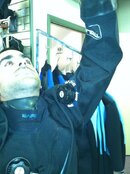73diver
Contributor
Hi Folks,
I went ice diving last weekend with my club and I had one of my usual problems when using my drysuit. When I don't have an ascent line (like a boat mooring or other references) I often have difficulty coming up the water column and making a nice controlled ascent and stop at the safety stop. I know it can be done because I was tending line as a couple of guys my age did it perfectly. It was a pleasure to watch such great control.
Since I can do this skill in my wetsuit I know it is a matter of practice and experience with my drysuit. I have decided that I am going to make frequent trips to the local quarry this spring and practice this skill until I've got it. Any advice from other old divers would be appreciated.
Thanks
I went ice diving last weekend with my club and I had one of my usual problems when using my drysuit. When I don't have an ascent line (like a boat mooring or other references) I often have difficulty coming up the water column and making a nice controlled ascent and stop at the safety stop. I know it can be done because I was tending line as a couple of guys my age did it perfectly. It was a pleasure to watch such great control.
Since I can do this skill in my wetsuit I know it is a matter of practice and experience with my drysuit. I have decided that I am going to make frequent trips to the local quarry this spring and practice this skill until I've got it. Any advice from other old divers would be appreciated.
Thanks





